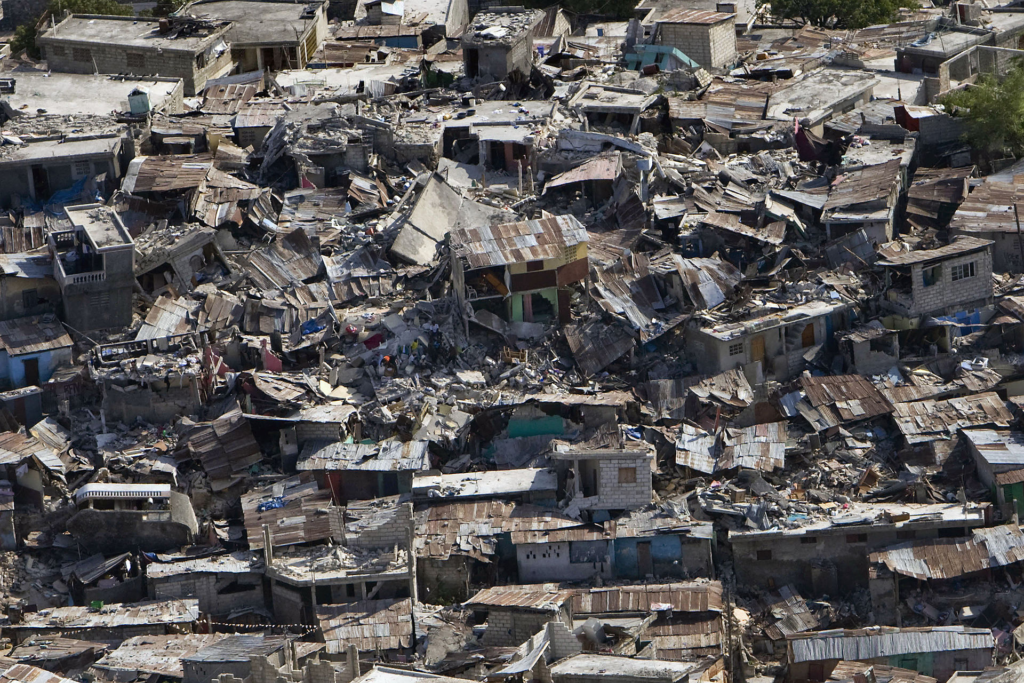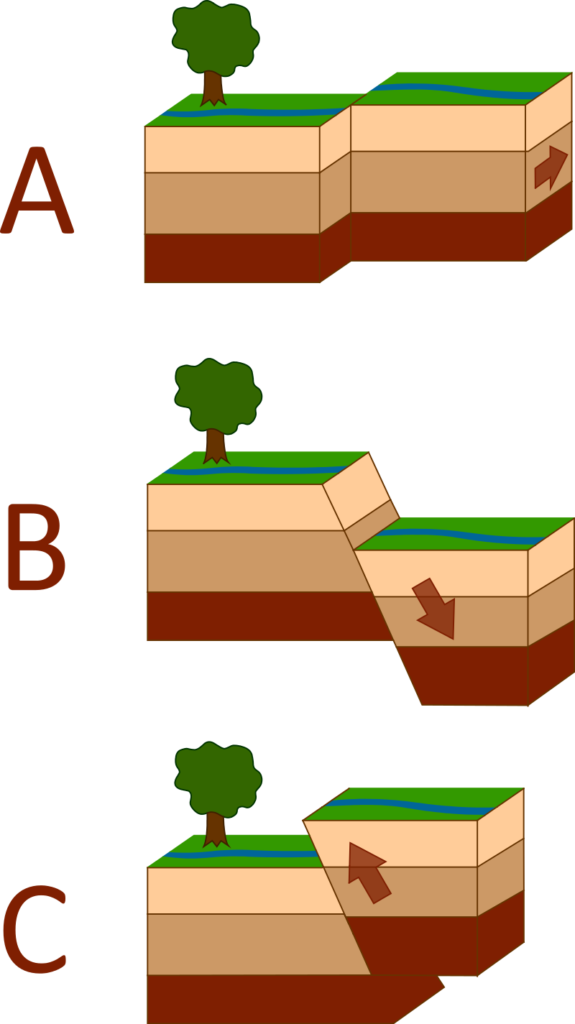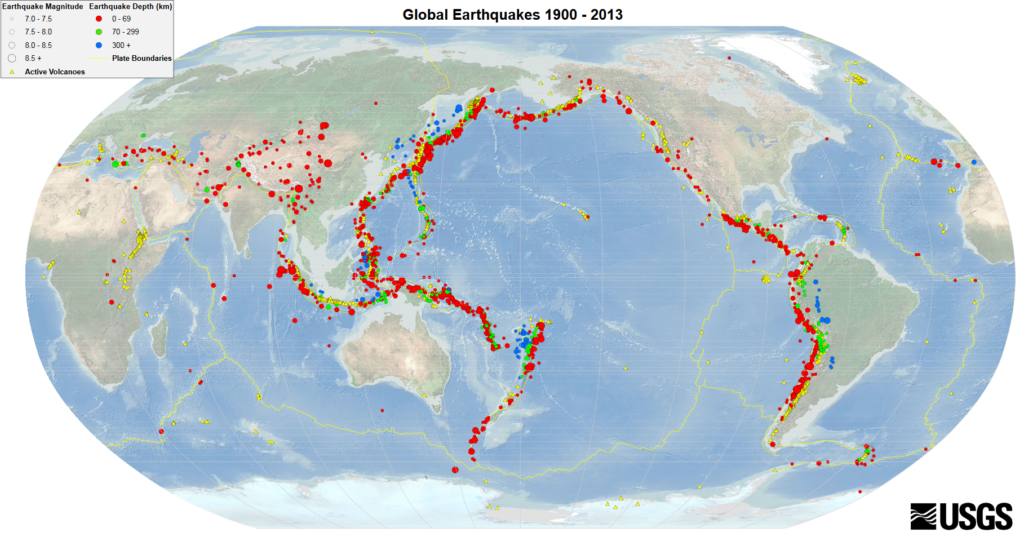Earthquakes

Earthquakes are the sudden movement of the ground as a result of two blocks of rock suddenly slipping against one another. In the study of the causes of earthquakes, we understand that part of our planet’s lithosphere is the massive tectonic plates that fit together like pieces of a puzzle. These tectonic plates are constantly moving very slowly, and at times their edges get stuck due to friction. The surface where two slabs of rock slip is named the fault or fault plane.
Pressure builds up in the fault plane until it overcomes the friction, and seismic energy is released in waves that travel through the Earth’s crust. These seismic waves cause the shaking experienced during an earthquake. An earthquake starts below the Earth’s surface at its hypocentre. The spot directly above the hypocentre is called the epicentre.
Smaller earthquakes called foreshocks can occur before a larger earthquake. The largest and main earthquake is called the mainshock. Foreshocks share the same origin as the mainshock. It is not possible to determine whether a shock is a foreshock or a mainshock until the larger earthquake occurs. Mainshocks are always followed by smaller earthquakes called aftershocks. Like foreshocks, aftershocks come from the same place as the mainshock. Aftershocks can continue for days, weeks, months, or even years depending on how large the mainshock was.
Where Earthquakes Happen

Earthquakes occur on the edges of tectonic plates called plate margins or plate boundaries. These are made up of many faults and fault planes. Most of the world’s earthquakes happen on the faults found on the many plate boundaries. The edges of plate boundaries are rough and easily catch on other rocks as the plate continues to move. When the plate boundary is finally released, it snaps back into place, triggering an earthquake.
Major earthquakes occur in areas called earthquake belts found on the edges of tectonic plates. The most notable is the Circum-Pacific Belt, also known as the Pacific Ring of Fire. Here seismic activity is not distributed equally and some points in the belt branch out. The Circum-Pacific Belt and its seismic activity pose significant consequences to populated coastal regions around the Pacific Ocean. This includes the coasts of Alaska, the Aleutian Islands, Japan, New Guinea, New Zealand, North America, and South America. Of all the energy produced by earthquakes in the world, 80% comes from earthquakes with epicentres found in this belt.
Another known earthquake belt is the Alpide belt. This belt passes through the Mediterranean, towards Asia in the east, and meets the Circum-Pacific Belt in the East Indies. The Alpide belt’s seismic energy accounts for around 15% of the world total.
Earthquakes also occur in connected belts of seismic activity mainly found along ridges under the ocean. Those in the Atlantic Ocean, the Arctic Ocean, the western Indian Ocean, and near the rift valleys of East Africa are examples.
Causes of Earthquakes
In the event that the edges of faults catch against each other, the rest of the plate remains in motion. Usually, the energy causes the two blocks to simply slide past each other, however, in this instance, it is stored up. There is a point where the force of the moving blocks is finally enough to overcome the friction and all the energy stored in the rock is released, spreading out in all directions as seismic waves. As these seismic waves travel through the Earth’s crust, they cause it to shake in different directions.
Natural Forces
Earthquakes result from the sudden release of energy from a specific region of the Earth’s rocks. This energy is released in a variety of ways, including the motion of large masses, elastic strain, chemical reactions, or gravity. Elastic strain is often regarded as the most significant factor because the elastic strain is the only one that can be stored in the Earth enough to generate major disturbances. Tectonic earthquakes are those that are related to elastic strain as a form of energy release.
Plate Tectonics
Earthquakes caused by the movement of the Earth’s tectonic plates and the elastic strain it produces are called tectonic earthquakes. This type of earthquake is explained by the elastic rebound theory, first posited by American Geologist Harry Fielding Reid. This theory states that tectonic earthquakes occur as a result of the build-up of strain in rock masses.
After some time, enough strain will have built up for the stress produced to be stronger than the rocks themselves, causing them to fracture suddenly. These fractures spread rapidly throughout the rock usually in the same direction. Fractures can continue spreading through a local zone of weakness many kilometres past their source.

The tectonic movement found along faults occur in irregular patterns that suddenly start, stop, and restart. This irregular action is primarily due to rock masses that are forced in different directions but eventually return to positions with less strain on the rock. This movement may not happen immediately, and take place in irregular steps of slowings and restarting. In this process, seismic waves are produced and emanate from the earthquake’s epicentre.
Fault ruptures usually originate from 5–15 kilometres below the Earth’s surface. This spot is called the earthquake’s focus. The rupture spreads over the fault plane in one or two directions until it meets a barrier. At this point, the rupture may either slow down or stop completely. At times, the fault rupture may recommence on the far side or even break the barrier and continue propagating. The roughness found along the fault is called an aspirate, while the zones at which the fault rupture slows down or stops are referred to as fault barriers.
The properties of an earthquake differ according to the type of fault or slip that causes it. Fault models usually depict a strike and a dip. In an inclined fault, the lower wall is called a footwall. Above the footwall is the hanging wall. Strike-slip faulting is when rock masses slip past each other while parallel to the strike. Depending on how the block on the opposite of the fault has moved left or right from the perspective of an observer, strike-slip faults are either right lateral or left lateral.
On the other hand, dip-slip faulting occurs when the movement of the rock masses are parallel to the dip. Dip-slip faults may either be normal faulting or reverse (thrust) faulting. The former is when the block of the hanging wall moves downward relative to the footwall block. The latter is when the opposite occurs and the hanging wall moves upward relative to the footwall.

It is assumed that all of the planet’s known faults have been the source of one or more earthquakes throughout history. However, tectonic movement along faults usually occurs at a slow pace, and the majority of geologically ancient faults no longer cause earthquakes and are therefore aseismic. It is important to note that actual faulting related to an earthquake may be complex. It is not certain whether the energy that one earthquake produces comes from just one fault plane.
At times, geologic faults that have been observed and studied have demonstrated relative displacements across hundreds of kilometres over geologic time. In contrast, seismic-wave-producing sudden-slip offsets may only be from a few centimetres to less than 100 metres long.
Volcanic Activity
Volcanic earthquakes are characterised by the conjunction of tectonic forces and volcanic activity. Earthquakes that fall under this type may be the outcome of an abrupt slip of rock masses near the volcano, resulting in the release of elastic strain energy. This stored energy may also be partly hydrodynamic and caused by the heat of magma moving inside the volcano’s chamber, or due to the release of pressurised gas.

Along the Pacific Ring of Fire and ocean ridges, there is an evident connection between the distribution of volcanoes and major earthquakes. However, in general, the epicentres of most major earthquakes are found many kilometres away from volcanic vents and volcanoes. The main sources of many earthquakes are rarely situated near active volcanoes. Earthquakes and volcanism are more likely to be caused by the same tectonic activity than be direct causes of each other. An earthquake may even occur directly below a volcanic structure, yet it is more probable that it has no immediate causal relationship with the latter.
Artificial Induction
Some earthquakes are the direct consequence of human activity. Artificial processes such as the detonation of powerful nuclear explosions, the injection of fluids into deep wells, the filling of large reservoirs, and underground mining and excavation.
Deep mining involves the removal of large amounts of rock, which leads to a change in the strain around the tunnel walls. It is possible for deep mining to result in the development of slip-on nearby, pre-existing faults, or the outward shattering and collapse of rock into the artificial chambers.
Fluid injection may lead to the premature release of elastic strain stored in the adjacent rock. The liquid involved in fluid injection may lubricate fault surfaces and potentially cause a slip.
Underground testing and explosion of large nuclear devices may also lead to the production of slip on already strained faults near the detonation site.
Reservoir induction
The filling of large reservoirs is one of the most significant sources of earthquakes caused by human processes. There have been more than 20 compelling cases where the collection of water behind large dams has resulted in increased local seismic activity. However, it is unsure whether the filling of the reservoir was the cause of such seismic activity, as there is no data on seismic activity in the area prior to and after the filling of the reservoir. The effects of reservoir induction are most pronounced for reservoirs that go beyond 100 metres in depth and 1 cubic kilometre in volume.
The prevailing hypothesis regarding reservoir induced seismic activity operates on the assumption that the rocks in the reservoir’s vicinity are already so strained from tectonic forces in the region that faults nearby are just about to slip. The fault rupture may also be triggered by the pressure from the large volume of water in the reservoir. It is also possible that the rocks along the fault have weakened because of increased water-pore pressure. However, it is important to note that the filling of most large reservoirs has not induced earthquakes large enough to be considered a hazard.
Frequently Asked Questions
What causes earthquakes?
Earthquakes are caused by the sudden release of energy in the Earth’s crust, usually as a result of the movement and interaction of tectonic plates.
How do tectonic plate boundaries contribute to earthquakes?
Earthquakes commonly occur at plate boundaries, where tectonic plates collide, separate, or slide past each other. The accumulated stress and strain along these boundaries are released during an earthquake.
What is the difference between a fault and an earthquake?
A fault is a fracture or zone of weakness in the Earth’s crust, whereas an earthquake refers to the shaking or trembling of the ground caused by the sudden movement along a fault.
Can earthquakes occur away from plate boundaries?
Yes, earthquakes can occur away from plate boundaries, although they are less common. These are often associated with intraplate seismic activity, such as faults within a tectonic plate or volcanic activity.
Can human activities contribute to earthquakes?
Yes, certain human activities can induce or trigger earthquakes. Activities such as hydraulic fracturing (fracking), mining, and the construction of large reservoirs can potentially cause seismic events.
Resources
Earthquake. (n.d.). Retrieved from Britannica: https://www.britannica.com/science/earthquake-geology/
Causes of Earthquakes in General. (n.d.). Retrieved from Swiss Seismological Service: http://www.seismo.ethz.ch/en/knowledge/things-to-know/causes-of-earthquakes/general/
The Science of Earthquakes. (n.d.). Retrieved from United States Geological Survey: https://www.britannica.com/science/earthquake-geology/
What causes earthquakes?. (n.d.). Retrieved from British Geological Survey: https://www.bgs.ac.uk/discovering-geology/earth-hazards/earthquakes/what-causes-earthquakes/
What Happens During an Earthquake?. (n.d.). Retrieved from Caltech: https://scienceexchange.caltech.edu/topics/earthquakes/what-causes-earthquakes
What is an earthquake and what causes them to happen?. (n.d.). Retrieved from United States Geological Survey: https://www.britannica.com/science/earthquake-geology/
Why Do Earthquakes Happen?. (n.d.). Retrieved from UPSeis: http://www.geo.mtu.edu/UPSeis/why.html






